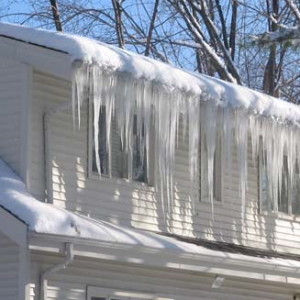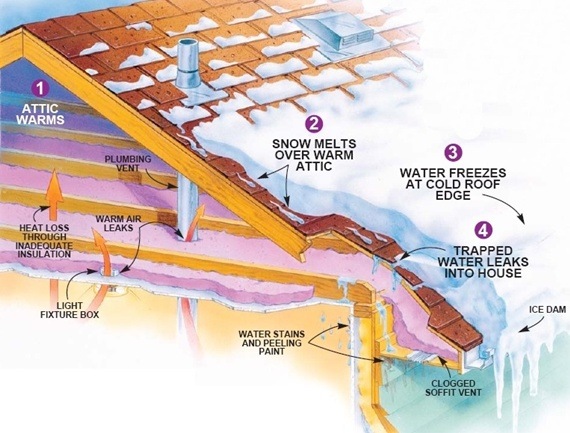These days we are using blower doors and infrared cameras to measure and observe where and how our homes leak air and waste energy. We call this an Energy Audit and it helps us diagnose failures in a homes system of enclosure – the building “envelope” – and target efforts to stop the waste.
 This winter nature did its own energy audit of our homes and produced striking graphs in the form of icicles hanging from our roof eaves. Of course I am talking about the ice dams you saw on houses everywhere this winter. It was interesting to “read” these graphs and try to understand just what they revealed about the ways our homes lose heat, which is exactly what an ice dam reveals.
This winter nature did its own energy audit of our homes and produced striking graphs in the form of icicles hanging from our roof eaves. Of course I am talking about the ice dams you saw on houses everywhere this winter. It was interesting to “read” these graphs and try to understand just what they revealed about the ways our homes lose heat, which is exactly what an ice dam reveals.
The most immediate thing nature’s audit reveals is the weak edge where the wall meets the roof. When we see ice dams we know that this junction is not thick enough to have enough insulation to keep the roof cold. We insulate to slow the transfer of heat to cold – the more insulation, the slower the transfer and the longer we retain the heat where we want it – inside! Too little insulation and the heat leaves the building and warms the roof above the wall, melting the snow which freezes along the edge building up a “dam” that forces the melted snow back into the house.
Aggravating this condition is the concentration of wood across the top of the wall and where the frame of the ceiling and roof come together there. Lots of wood offers the heat in the building a “bridge” to the outside, again warming the roof and creating the conditions that form the ice dams. You can also see this effect when there is a dusting of snow on a roof and the outline of the (warm) rafters can be observed, another graph from nature’s energy audit. We call these “thermal bridges” and we have been building them into houses for hundreds of years.
Speaking of which, hundreds of years back houses weren’t kept warm enough for these conditions to occur. It was easy to identify unoccupied homes this winter because the snow sat like a pillow on the cold roof because there was little or no heat on inside. That or a frugal homeowner wearing a hat and sweaters! With mechanical heating systems we keep our homes warm enough and insulate and air seal them poorly enough to cause this problem.
 Which brings us to this. Our homes are generally poorly air sealed, so that warm air inside the house is leaving it along these very same edges. Couple this with gaps inside our walls and warm light fixtures at our ceilings and we have unwittingly installed what is effectively a radiator to warm the roof and melt the snow.
Which brings us to this. Our homes are generally poorly air sealed, so that warm air inside the house is leaving it along these very same edges. Couple this with gaps inside our walls and warm light fixtures at our ceilings and we have unwittingly installed what is effectively a radiator to warm the roof and melt the snow.
With nature’s energy audit revealing the symptoms of this endemic problem in our homes how do we target our efforts to stop the waste that is causing the problem, or at the very least, prevent the leaks when these conditions occur. There are two actions to take. The best, though often the more difficult, is to eliminate air leakage and improve insulation and reduce thermal bridges. Probably the best way to do this is to add thickness to the roof, often a difficult or aesthetically challenging proposition. But it can be done and the benefit will be a more comfortable home that uses less energy.
The other action, which should be done on every home that cannot improve its insulation, is to install an impenetrable barrier beneath the roof shingles, usually referred to as “ice and water shield.” Any time you replace a roof this should be done, and may even be done 3-4 feet up a roof that may not need the whole roof replaced. This however, is a band aid. You will still be wasting energy and the ice dams will still form, it just won’t leak into the house.
While we still learn a lot from the diagnostic equipment available today, knowing how to read the clues that natural processes reveal can make it abundantly clear that our homes are not working.
